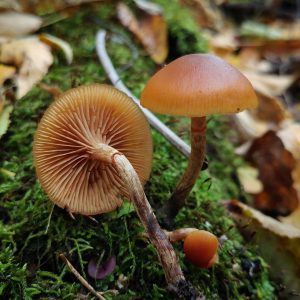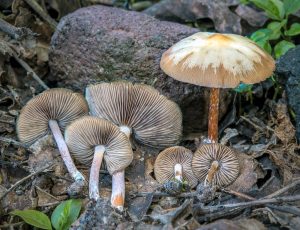Alabama[i] is among the most biodiverse states in the US, thanks to its inclusion of several different biophysical regions, from the Appalachians to the Gulf Coast, and because the whole state is warm and wet. Plus, it is still almost 70% forested. A state like this is sure to have plenty of mushrooms, but unfortunately information is a little hard to find—you’ll notice that in a few places we haven’t been able to track down species names, only genera. But we have managed to collect some examples of the bounty that is out there[ii].
For educational purposes only, this compilation serves as a reference and should not be treated as a substitute for a field guide, spore prints, or an identification app. When venturing into the realm of mushroom hunting, it is strongly recommended to seek guidance from experienced individuals in person. Furthermore, it is advisable to equip oneself with a high-quality knife along with a basket or bag.
Most mushrooms are safe to eat, and while there is a learning curve for mushroom identification, once someone has become truly familiar with mushrooms, most are not hard to identify. But do be cautious, since beginners often make mistakes experienced foragers wouldn’t, since it takes time to really sensitize the eye to notice the important details. Here are a few reasons to put in the work to get up that learning curve.
Our Recommended Field Guides for Alabama
COVER | TITLE | Header | ||
|---|---|---|---|---|
OUR #1 RATED | ||||
Edible Mushrooms
Cauliflower Mushroom (Sparassis sp.)


The cauliflower mushroom looks a bit more like a pile of noodles than a cauliflower, but you can still understand why it has the name. They can be used in recipes to replace noodles, too, but they’re also great in soups, risottos, or you can steam them, then press them and fry them into crispy “steaks.”[iii] There are several different species, but they all look quite similar and all cook the same.
Parasol Mushroom (Macrolepiota procera)


Parasols are large, whitish mushrooms with brownish scales on the cap and brownish marks on the stem. They are considered choice edibles. Unfortunately, they closely resemble both the Shaggy Parasol group and the Dapperling group, both of which have poisonous members—it’s not that you can’t tell parasols apart from the others, you just have to pay attention. Also, it seems that any large, whitish mushroom can be mixed up with Destroying Angels by foragers engaging in wishful thinking—and that is a mistake a forager can only make once.
Oyster Mushrooms (Pleurotis sp.)


Oyster Mushrooms don’t taste like oysters (they have a delicate, almost perfumed flavor and a soft and delicate texture) but some do look a bit like oysters, being round, stemless or nearly so, and pale gray or white. There are several different species, plus a few inedible look-alikes. Oyster mushrooms have become better-known in recent years because they are easy to grow—they aren’t usually available in stores, as their shelf-life is short, but many people grow them at home by ordering kits.
Lion’s Mane (Hericium erinaceus)


Lion’s Mane is famous for looking odd and tasting like crab meat—to the point that it can be used to make a credible crab-cake. As for odd-looking, the lion’s mane fruiting body is large, globular, and covered with soft, hair-like spines. Imagine a whitish pompom sprouting from an old wound in a tree-trunk. Surprisingly, the spines do not feel like anything particular in the mouth—they don’t need to be removed for cooking, and you won’t notice them while eating.
There are two other Hericium species that may also live in Alabama. They fork or branch, and they lengths of their spines differ, but they taste about the same.
Crown-tipped Coral Mushroom (Artomyces pyxidatus)


Coral fungi get their name from their odd shape—they are clusters of thin, many-branched stems, rather like certain types of coral or, for a land-based metaphor, reindeer lichen. Not all coral fungi are safe to eat, but Crown-Tipped Corals are, though they can be difficult to clean. You could try cooking them lightly by dropping bite-sized pieces into hot broth[iv].
Hen-of-the-Woods (Grifola frondosa)


Hen-of-the-woods (not to be confused with the similarly-named chicken-of-the-woods) does look like a pile of gray chicken feathers. It’s the same thing as Japanese Maitake, and makes a very good cheese-steak, or, rather, cheese-mushroom—that is, if you are familiar with Philly cheesesteaks, simply grill these mushrooms with cheese in a similar way. This species does have a number of look-alikes, but fortunately most (not necessarily all) are also good to eat.
Our Recommended Field Guides for Alabama
COVER | TITLE | Header | ||
|---|---|---|---|---|
OUR #1 RATED | ||||
Poisonous Mushrooms
Not all poisonous mushrooms are deadly. In fact, most are only mildly poisonous, and many cause no symptoms at all in some people. But the following three should provide plenty of reason for foragers to exercise caution.
Deathcap (Amanita phalloides)


The Deathcap may be the deadliest mushroom in the world, not least because is has almost certainly been used as a murder weapon. It’s native to Europe but has been accidentally brought to North America on imported nursery stock. It doesn’t spread easily on it’s own, so in Alabama you are most likely to see this mushroom in suburban or urban areas fruiting near the trees they came in on—it can take decades for the fungus to begin fruiting, so don’t be surprised if you see it popping up where you’ve never seen it before, it’s just been laying low.
The Deathcap is a large, handsome mushroom with a greenish or brownish cap. It is also the world’s best reason to teach your children not to eat things they find outside and to keep an eye on your dogs. Should you suspect anyone in your care may have eaten a Deathcap, call Poison Control (yes, there is a Poison Control number for pets, too), then head to the emergency room and bring a sample of the mushroom. Survival is sometimes possible with appropriate medical treatment, but amotoxin poisoning is difficult to diagnose, and misdiagnosis will be fatal.
Destroying Angel (Amanita bisporigera)


The Destroying Angels are a group of similar-looking mushroom species across Europe and North America. This one is the species common in Eastern North America, but you really don’t need to know which destroying angel you’ve got—the main thing is not to eat it, as it contains the same toxin that Deathcap does, and in similar amounts. It looks similar, too, except it is all-white (some species may be slightly pinkish). For some reason, Destroying Angel is sometimes mistaken for virtually all large, white or whitish edible mushrooms out there, even those that are otherwise not similar-looking. Foragers, please pay attention to detail.
The tricky thing about amotoxin is that symptoms can be delayed for up to a day, so victims might not realize that their illness has anything to do with the mushroom dish. Then, the initial gastrointestinal symptoms will go away after a day or do, fooling some doctors into sending the patient home—when what’s actually happening is the toxin is secretly attacking the liver and kidneys, either of which may fail.
There is something fascinating about a seriously dangerous mushroom.
Deadly Galerina (Galerina marginata)


Ah, the Deadly Galerina, the little mushroom full of amotoxin that also looks almost exactly like—and likes to grow mixed in among—several popular edible species and nearly all of the magics. That is, you could find a group of ten identical-looking mushrooms, carefully key out nine of them as some choice edible, then harvest and eat all ten and die because the tenth was the Deadly Galerina. It’s not literally identical to other species, it’s just that you won’t notice the differences if you don’t carefully check for them. “This looks about right” isn’t good enough.
Our Recommended Field Guides for Alabama
COVER | TITLE | Header | ||
|---|---|---|---|---|
OUR #1 RATED | ||||
Magic Mushrooms
Alabama has its share of psychoactive mushrooms[v], but would-be foragers should take care. First, possession of psilocybin is against both state and federal law. Second, most magics bear a very close resemblance to each other and to the Deadly Galerina. Mistaking a highly-potent mushroom for a moderately potent one could lead to a dangerous overdose. Mistaking the aptly-named Deadly Galerina for a a psychoactive species would be a good deal worse. Even people familiar with these mushrooms from cultivation should not harvest them wild without extensive experience identifying wild mushrooms.
Psilocybe cubensis


Psilocybe cubensis is perhaps the best-known of the magic mushrooms because it is widely cultivated, with many strains having been developed and named by breeders. It’s no well-known, in fact, that it represents a sort of baseline against which other psychoactive species can be described. In the wild, it feeds on the dung of large mammals, such as cattle and horses, and prefers warm climates.
Psilocybe caerulescens


This species is not well known and is difficult to identify in the wild because it is highly variable. It can be small or large, and depending on its condition, can be reddish, yellowish, or blue-black. It likes growing in recently-disturbed, open areas.
Panaeolus cyanescens


This mushroom, nicknamed Blue Meanies (a name it shares with a popular Psilocybe cubensis variety), is among the most potent psychoactive species known. It is typically pale, bluish gray.
Panaeolus cinctulus


This, the Banded Mottlegill, gets its common name from the pale ring around the outer margin of the cap. It is very widespread. But of weak to moderate potency.
Gymnopilus sp.


The jims, as psychonauts call them, are a group of small, brownish mushrooms that are difficult to sort out to species. There isn’t much information available on what taking them is like, but they are definitely psychoactive.
References:
[i] (n.d.). Alabama. Wikipedia
[ii] Ana (2023). Common Edible Mushrooms in Alabama. Foraging Guru
[iii] Bergo, A. (2023). Cauliflower Mushroom Steak. Forager Chef
[iv] Bergo, A. (2023). Crown-Tipped Coral Mushrooms. Forager Chef
[v] (n.d.). Which Psilocybin Mushrooms Grow Wild in My Area? Shroomery
Our Recommended Field Guides for Alabama
COVER | TITLE | Header | ||
|---|---|---|---|---|
OUR #1 RATED | ||||






